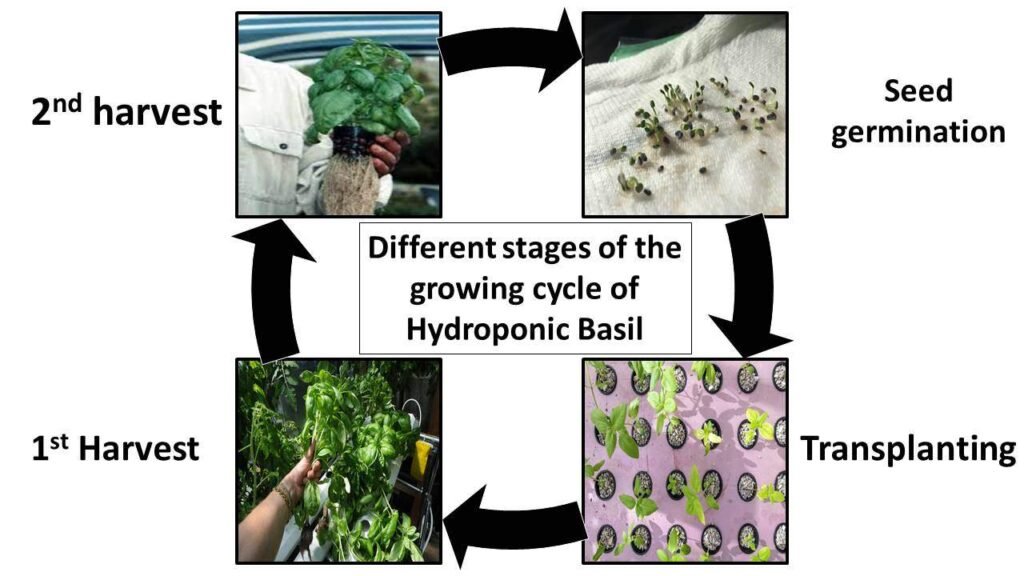HYDROPONIC BASIL: Cultivation with Unparalleled Precision
Basil commonly known as “TULSI” is a very important herb plant. It has significance in our culture and religion. Tulsi is embraced for its role in promoting holistic wellness, addressing physical, mental, and spiritual aspects of health. Medicinally, it is valued for its healing properties. It is a potential herb that can be grown in a hydroponic system and gives more yields per unit area than open field cultivation. As now climatic conditions are not in the favor of farmers and they have to opt for such future technologies to solve different challenges faced in open fields. Hydroponic basil gives more yield, intense flavor and aroma to plants compared to that in soil grown basil.

Preliminary:
Basil (Ocimum basilicum) is a virtuous plant in India. It belongs to the family of mints “Lamiaceae”. Two major species are grown widely which are (ocimum basilicum) Sweet basil or Bubai Tulsi and (ocimum canum) Holy basil or Kali tulsi. Now hydroponic basil has gained popularity due to the huge number of benefits compared to other methods of cultivation. In open field conditions there are challenges faced by farmers due to climate change and increase in the number of insect pests. On the other hand hydroponic basil does not even solve these problems but gives better growth and more yield.
Why Hydroponics is Best Choice for Basil:
Herbs are best choices for hydroponics as they are shallow rooted and directly uptake nutrients and water from solution. Balancing the amount of ph, moisture, light, and nutrients gives excellent growth to plants. This balance is difficult to achieve in an open field and can be maintained in a hydroponic system.
Faster Growth and Higher Yields:
In hydroponics the environment and nutrients are under control by the farmers. This helps in getting better yield compared to open field cultivation. As the climate is not a factor and by providing optimum temperatures at different growth stages gives rapid growth.
Indoor Gardening:
Hydroponics allows a farmer to set up their hydroponic farm in an indoor infrastructure. It allows farmers to go for year round production. This system is a space efficient system. Farmers having less land can also go for hydroponics to get more profit from small land (in metropolitan cities).
Basil is a water loving plant but cannot tolerate water logging conditions:
Water imbalance also causes various problems as mentioned above. In hydroponics this will not happen as a full control on water can assure the thing. Balance is also essential for proper shape and texture of leaves.
Full Control on Environment and Nutrition:
Conditions like humidity, light, pH, temperature are under check by the farmer and can be maintained. The optimum pH required for growing basil is 5.5 to 6.5. This ensures the nutrients are absorbed by the plant. These conditions are under control in the hydroponic system.
Less Chances of Infection:
This system prevents the plants from the soil borne pathogens and infections. The use of different pesticides can be excluded by maintaining aseptic conditions inside farms. It also ensures protection from insects and pests. Also weeds are not a concern in the hydroponic system as compared to soil cultivation. There is no competition for basil plants for any nutrition and water.
Growing Techniques of Basil:
Any growing technique can be used in hydroponics to grow basil but two are the most popular. These are Deep water culture (DWC) and Nutrient Film Technique (NFT). This choice is made by the availability of space resources and available sources. In the DWC method the oxygenated water solution is used to hold the plants. This solution is enriched in nutrients and promotes strong plant growth. On the other hand in NFT a thin film of nutrient rich water flows over the plant roots, providing a continuous supply of nutrients.
Different stages in one growing cycle:
| Stages | Time taken |
| Seed germination | 5-7 days after sowing |
| Transplanting | 3-4 weeks after germination |
| 1st harvest | 3-4 weeks after transplanting |
| 2nd harvest | 2-3 weeks after 1st harvest |
Germination of seeds can be done in the plug trays in sufficient moisture. Contamination free media should be used to avoid infections in seedlings. Otherwise seedlings can be purchased from certified companies.

Optimum Conditions for Hydroponic Basil:
The main reason behind hydroponic basil is that we can maintain the optimum conditions which are desired by the plant. Optimum conditions like temperature, pH, light, and other factors significantly increase the growth and result in high yield. Here are optimum conditions which can be maintained:
| Temperature | 210 C to 270 C |
| Relative humidity | Between 50 to 60% |
| pH | 5.5 to 6.5 |
| Electric conductivity | 1.2 to 2.0 mS/cm |
| Light duration | 12 to 16 hours |
Important Practices During Cultivation of Hydroponic Basil:
Management is a key aspect in ensuring profit and success. These are some important practices which are needed.
Maintenance of growing environment:
Temperature range of 210C to 270C is optimum and to be maintained. Basil responds well to a spectrum of light including blue and red. To strengthen basil plants proper air circulation is necessary, it allows equal amounts of carbon dioxide to each plant.
Optimum EC levels:
EC (Electrical conductivity) plays an important role in the absorption of nutrients by the plant. The EC levels should be within range of 1.2 to 2.0 mS/cm (millisiemens per centimetre) during vegetative growth stage.
Pruning and harvesting:
Hydroponic basil needs regular pruning. Pruning during vegetative growth allows thick arrangement of leaves and allows bushier like growth. Harvesting promotes regular growth so harvesting should be done when it reaches a desirable height. Pruning also prevents flowering.

Regular checking for clogs:
This system totally depends upon the supply of the water solution. If at any time it stops it will hinder the growth and the plant will die if duration extends. So checking for clogs is a very important practice. Clogs will be removed immediately if occurs. Yes, weeds are not so much of a problem in hydroponics but the growth of algae should be checked. Algae can grow in different locations in the system and should be eliminated.
Challenges in Growing Hydroponic Basil:
Certainly, the hydroponic basil approach offers numerous advantages, it also presents some challenges.
To establish a hydroponic farm:
This is a challenge to establish a hydroponic farm as it needs a high investment. The infrastructure is costly and it needs proper engineers to set up. It also needs flat lands for setup. Yes, one can get the cost in the long run but initially it is a challenge.
Need of Skilled Labour:
The need for skilled labour in hydroponics is significant due to the specialised knowledge and tasks involved in operating and managing hydroponic systems. Works like system installation and maintenance, data monitoring and analysis, and quality control needs specific skills.
Relying on Electricity:
The whole setup is run on electric power. Maintenance of temperature, pumping solution all depend on electric power. A power outage can lead to cessation of operations. However this problem needs a backup of electric supply which gradually increases the investment cost.
Diseases:
Soil borne diseases are not a concern in hydroponics as it excludes use of soil. Nonetheless, it doesn’t eliminate the potential for diseases to occur. Waterborne illnesses may propagate through a contaminated water supply. Additionally, certain types of algae can impede the growth of the plants we desire.
Maintenance of Components:
It is a challenge to maintain the whole system. It is a large setup and managing everything is difficult. Components of hydroponic systems like growing medium, reservoir, pumps, tubes (in which nutrient solution flows), pH metre, EC metre, temperature control, drainage system are to be maintained accurately. Clogs in the system can also lead to damage to the system. As a whole the system depends upon the supply of solutions.
Need of Proper Time Management:
If there is delay in the steps of cultivation, the procedure leads to less profit and failure. Transplanting at the right stage helps in better growth of plants. Harvesting schedules must be right so that proper length and compactness in leaves remain desirable. Delay in such stages causes loss in venture.
Conclusion:
So, we see numerous benefits of hydroponic basil and how it works. Yes, it is a better option of cultivating hydroponic basil, but this cannot be approached blindly without any guidance and training. This setup needs high investment so that each step taken toward this should be well researched and scientific. First a person has to become skilled in this field and then to approach hydroponics otherwise this profitable setup can become a huge loss.
In the end I must want to conclude that this hydroponic technique is a successful technique and will have great use in the future. As we notice our soils are now not that fertile and climate change also does not favour farmers. So the government should take some steps to encourage these new future techniques so that low land farmers can approach them. The encouragement can be done by offering free educational programs for farmers, and by providing subsidies and incentives to hydroponic farming.
Join Our Hydroponics Growers Group!
Connect with fellow hydroponics enthusiasts, share your ideas, ask questions, and grow together as a community.
👉 Join WhatsApp Group






